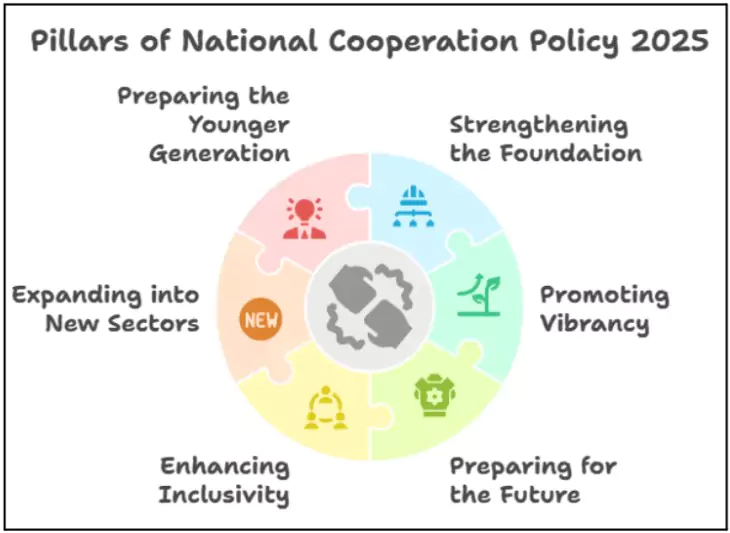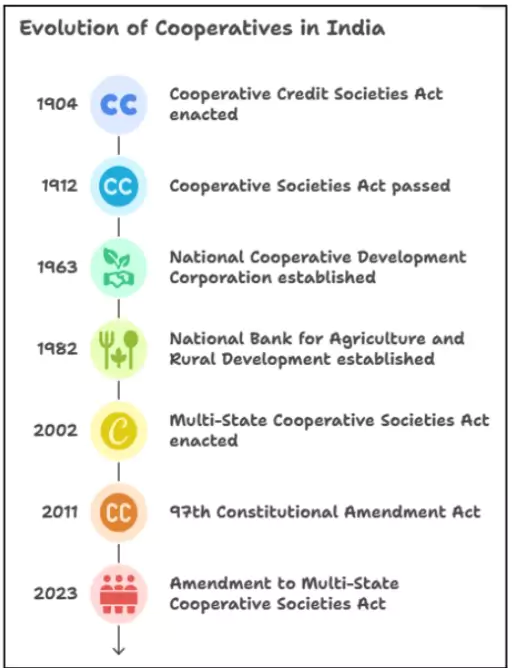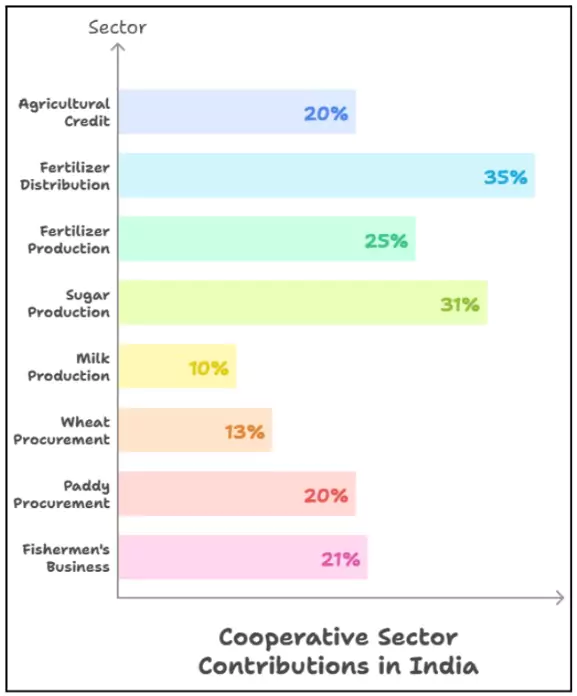Recently, the Union Home and Cooperation Minister unveiled the National Cooperation Policy 2025 in marking a major reform step for inclusive rural development.
- The declaration aligns with the UN-designated International Year of Cooperatives 2025, emphasizing the global recognition of cooperatives in achieving inclusive and resilient growth.
- The International Day of Cooperatives is celebrated annually on the first Saturday of July; in 2025, it was observed on July 5.
- 2025 theme: “Cooperatives: Driving Inclusive and Sustainable Solutions for a Better World”, highlighting their role in sustainable development and social equity.
- The Government of India introduced the first Cooperation Policy in 2002.
About National Cooperation Policy 2025
- Visionary Reform: The policy embodies PM Modi’s vision of ‘Sahkar Se Samriddhi’, promoting prosperity through cooperative efforts.
 Formation Process: Drafted by a 40-member committee led by former Union Minister Suresh Prabhu including stakeholders including RBI and NABARD.
Formation Process: Drafted by a 40-member committee led by former Union Minister Suresh Prabhu including stakeholders including RBI and NABARD.- Objective: To build an inclusive, tech-driven, and future-ready cooperative sector that supports India’s Viksit Bharat vision by 2047.
- Goals of National Cooperation Policy 2025:
- Expand Scale and Impact: Increase the number of cooperatives by 30% and triple their GDP contribution by integrating 50 crore active members by 2034.
- Achieve Universal Coverage: Establish at least one primary cooperative unit in every panchayat to ensure grassroots-level outreach.
- Six pillars of the National Cooperation Policy 2025 to achieve the goal for the cooperative sector were also included.
Key Provisions of National Cooperation Policy 2025
- Model Cooperative Villages: Establishment of five model cooperative villages in every tehsil, beginning with a pilot in Gandhinagar (NABARD-led).
- Sectoral Expansion: Promotion of cooperatives in tourism, taxi services (Sahkar Taxi), insurance, and green energy; profits to benefit Primary Agricultural Credit Societies (PACS).
- Employment & Youth Linkages: Policy aims to generate jobs by establishing one cooperative in every village and increasing youth participation.
- Technology Integration: Focus on computerisation and tech-driven transparent management, especially in PACS, to improve accountability.
- Inclusivity Focus: Prioritizes villages, rural women, Dalits, and tribals; aims for equitable growth via member-centric development.
- Training & Education: Establishment of Tribhuvan Sahkari University to build skilled manpower for the cooperative ecosystem.
- Implementation Roadmap: 83 intervention points identified; work completed on 58, with legal updates planned every 10 years.
- Global Aspirations: National Cooperative Exports Limited established for international trade and global market access of Indian cooperative products
About Cooperative Societies

- Cooperative societies are voluntary associations of individuals who join together to meet their common economic, social, and cultural needs and aspirations.
- They operate on the principle of mutual help and self-help, prioritising the well-being of their members over profit maximisation.
- Status of Cooperative Societies In India:
-
- Currently there are more than 8 lakh cooperative societies registered in various fields like Housing, Dairy, Agriculture, Finance, etc.
- In 2021, the Ministry of Cooperation was created by the Government of India for realising the vision of ‘Sahkar se Samriddhi’.
- Jurisdiction: Cooperatives are a state subject under the Constitution.
- The subject ‘Cooperative Societies’ is mentioned in entry 32 of the State List under the Seventh Schedule of the Constitution.
Types of Cooperative Societies in India
- Consumer Cooperatives: These societies aim to provide quality goods and services to their members at affordable prices. Examples include Kendriya Bhandar and Apna Bazar.
- Producer Cooperatives: These societies support small producers by providing them with resources, technology, and market access. Examples include Amul Dairy Cooperative and Karnataka Handloom Weavers’ Cooperative Society.
- Marketing Cooperatives: These societies facilitate the collective marketing of agricultural and other products, ensuring better prices for their members.
- Credit Cooperatives: These societies offer financial services like loans and savings to their members, particularly those from rural and marginalised communities. Examples include Urban Cooperative Banks and Rural Cooperative Banks.
- Housing Cooperatives: These societies provide affordable housing solutions to their members by pooling resources and collectively developing housing projects.
- Multi-State Vs Single-State Cooperative Societies in India
-
- Multi-State Cooperatives operate across multiple states and are governed by the Multi-State Cooperative Societies Act, 2002, while Single-State Cooperatives operate within one state and follow the respective State Cooperative Societies Act.
- IFFCO, Amul, and NCDFI are Multi-State Cooperatives; State Cooperative Banks and PACS are State Cooperatives.
Status of Cooperatives in India
- Current Numbers: India has 8.3 lakh cooperative societies.
- Diverse Activities: Over 4,000 PACS approved to open PM Jan Aushadhi Kendras.
- Other Cooperatives are involved in fuel retail, LPG distribution, and rural water and solar schemes.
Constitutional Provisions for Cooperatives in India
- 97th Constitutional Amendment : Added Part IXB (The Co-Operative Societies) to the Constitution.
- The Right to Form Cooperative Societies was included as the Right to Freedom under Article 19 (1).
- Article 43-B that deals with Promotion of Cooperative Societies was also inserted as one of the Directive Principles of State Policy.
- Multi-State Co-operative Societies (Amendment) Act, 2023: Amendment has been brought in the MSCS Act, 2002 to strengthen governance, enhance transparency, increase accountability, reform electoral process and incorporate provisions of 97th Constitutional Amendment in the Multi State Cooperative Societies.
The Role of Cooperatives in India
Cooperatives have played a pivotal role in India’s socio-economic development, particularly in rural areas. They have empowered millions of people, improved livelihoods, and contributed to national growth.
Rural Development
- Increase credit availability: Cooperative banks and credit societies provide affordable credit to farmers and rural entrepreneurs, enabling them to invest in their businesses and improve productivity.
- Cooperatives provide 20% of the total agricultural credit in the country, ensuring access to finance for farmers.
 Agriculture Input Supply: Cooperatives procure and distribute quality agricultural inputs like seeds, fertilisers, and pesticides at reasonable prices, ensuring timely access for farmers.
Agriculture Input Supply: Cooperatives procure and distribute quality agricultural inputs like seeds, fertilisers, and pesticides at reasonable prices, ensuring timely access for farmers.-
- E.g. IFFCO (Indian Farmers Fertiliser Cooperative) supplies fertilisers and agricultural products to millions of farmers at reasonable prices.
- Market Access to farm produce : Cooperatives facilitate market access for farmers by aggregating their produce, negotiating better prices, and connecting them to domestic and international markets.
- For example Sahyadri Farms, Maharashtra have successfully demonstrated how cooperatives can increase market access for farmers.
- Rural Infrastructure Development: Cooperatives often invest in rural infrastructure, such as irrigation systems, roads, and storage facilities, which benefits the entire community.
- For Example , NABARD provides refinancing for cooperative infrastructure projects like cold storage and processing units
Poverty Reduction
- Income Generation: Cooperatives provide employment opportunities, both directly and indirectly, to a large number of people, especially in rural areas.
- For instance, the Amul Dairy Cooperative has provided livelihoods to millions of dairy farmers in Gujarat.
- Skill Development: Cooperatives often organise training programs to enhance the skills of their members, enabling them to improve their productivity and income.
- SEWA (Self-Employed Women’s Association) is a cooperative that helps women develop skills in handicrafts, garment making, and more, enabling them to increase their income and economic independence.
- Social Safety Nets: Cooperatives can act as social safety nets, providing support to their members during times of economic hardship or natural disasters.
Social and Economic Empowerment
- Women’s Empowerment: Women’s self-help groups, which are often cooperative-based, empower women by providing them with financial resources, training, and a platform to voice their concerns.
- Lijjat Papad Founded in 1959 is a successful case study in women’s employment, demonstrating how a cooperative business model can empower women and promote their economic independence.
- Community Development: Cooperatives contribute to community development by investing in education, healthcare, and other social welfare activities.
- For example, the Krishak Bharati Cooperative Limited (KRIBHCO) has built schools and hospitals in rural areas to improve the quality of life for its members and the broader community.
Food Security
- Increased Agricultural Productivity: Cooperatives promote the adoption of modern agricultural practices, leading to higher yields and improved quality.
- Cooperatives contribute to 31% of the total sugar production in the country and more than 10% of the total milk produced in India.
- They contribute to more than 21% of the fishermen’s business, supporting the fishing industry and coastal communities.
- Efficient Food Distribution: Cooperatives ensure the efficient distribution of food grains and other agricultural products, reducing wastage and ensuring food security.
- Price Stabilisation: Cooperatives can help stabilise prices by acting as both buyers and sellers of agricultural products.
- Cooperatives procure more than 13% of wheat and 20% of paddy produced in the country, ensuring fair prices for farmers. E.g. National Agricultural Cooperative Marketing Federation of India Ltd.(NAFED)
Present Challenges Faced by Cooperatives in India
- Weak Governance and Accountability: Many cooperatives suffer from ineffective governance structures, limited transparency, and low member participation, leading to mismanagement and corruption.
- The Punjab and Maharashtra Cooperative Bank (PMC Bank) faced a major crisis due to Crony Capitalism leading to a severe liquidity crunch and inconvenience to its depositors.
- Financial Instability and NPAs: Access to finance remains limited, especially in rural areas. High interest rates and growing non-performing assets (NPAs) have weakened many cooperatives.
- RBI cancelled the licences of 53 cooperative banks across India between 2021 and 2025.
- Skill Deficits and Capacity Constraints: Lack of trained personnel, weak financial management, and insufficient training institutions limit the operational efficiency and leadership quality of cooperatives.
- Limited Technological Adoption: Only 45% of cooperative members are familiar with digital tools, slowing modernisation and reducing competitiveness in an increasingly tech-driven economy.
- Political Interference and Internal Conflicts: Cooperatives often face political influence, internal rivalries, and lack of awareness among members, which erode democratic functioning and collective decision-making.
- Regional and Functional Imbalances: Cooperatives remain underdeveloped in the eastern and northeastern regions, with many societies remaining small, single-purpose, and poorly coordinated at different levels.
Other Government Initiatives to Strengthen Cooperatives
- Ministry of Cooperation: The establishment of the Ministry of Cooperation in 2021 has provided a dedicated platform for addressing the needs and challenges of the cooperative sector.
- Financial Support: The government provides financial assistance to cooperatives through various schemes and programs.
- For Example under Computerization of Primary Agricultural Credit Societies (PACS) scheme government has allocated ₹2,516 crore to computerize nearly 63,000 PACS.
- Targeting different Sectors:
- Digital Services: PACS are being transformed into Common Service Centers (CSCs) to deliver a wide range of e-services to rural citizens.
- Healthcare: PM Bhartiya Jan Aushadhi Kendras are being operated by PACS to improve access to affordable medicines in rural areas.
- Energy: Under the PM-KUSUM Convergence scheme, PACS are promoting solar energy adoption among farmers for sustainable agriculture.
- Fisheries: Fish Farmer Producer Organizations (FFPOs) are being formed to empower fish farmers and enhance their market access.
Conclusion
The National Cooperation Policy 2025 envisions a self-reliant and inclusive cooperative economy through legal reforms, sectoral diversification, and grassroots empowerment. By promoting transparency, tech integration, and equitable participation, it aims to make cooperatives a key driver of India’s socio-economic transformation and the Viksit Bharat vision by 2047.
![]() 25 Jul 2025
25 Jul 2025

 Formation Process: Drafted by a 40-member committee led by former Union Minister Suresh Prabhu including stakeholders including RBI and NABARD.
Formation Process: Drafted by a 40-member committee led by former Union Minister Suresh Prabhu including stakeholders including RBI and NABARD.
 Agriculture Input Supply: Cooperatives procure and distribute quality agricultural inputs like seeds, fertilisers, and pesticides at reasonable prices, ensuring timely access for farmers.
Agriculture Input Supply: Cooperatives procure and distribute quality agricultural inputs like seeds, fertilisers, and pesticides at reasonable prices, ensuring timely access for farmers.